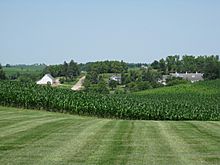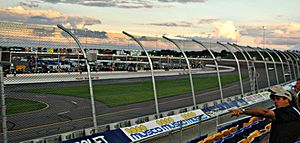Newton, Iowa facts for kids
Quick facts for kids
Newton, Iowa
|
|
|---|---|
|
City
|
|
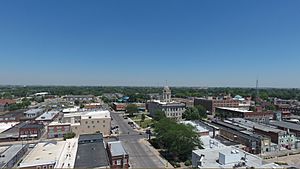 |
|
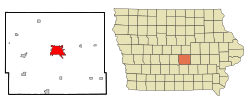
Location of Newton, Iowa
|
|
| Country | United States |
| State | Iowa |
| County | Jasper |
| Area | |
| • Total | 11.34 sq mi (29.37 km2) |
| • Land | 11.34 sq mi (29.37 km2) |
| • Water | 0.00 sq mi (0.00 km2) |
| Elevation | 951 ft (290 m) |
| Population
(2020)
|
|
| • Total | 15,760 |
| • Rank | 26th in Iowa |
| • Density | 1,390.02/sq mi (536.69/km2) |
| Time zone | UTC-6 (Central (CST)) |
| • Summer (DST) | UTC-5 (CDT) |
| ZIP code |
50208
|
| Area code(s) | 641 |
| FIPS code | 19-56505 |
| GNIS feature ID | 0459514 |
Newton is a city in Iowa, USA. It's the main city in Jasper County and has the most people living there.
Newton is about 30 miles (48 km) east of Des Moines, right in the middle of Iowa. In 2020, about 15,760 people lived in Newton. This city is known for the Iowa Speedway (a race track) and Maytag Dairy Farms, which makes delicious cheese!
Contents
History of Newton
How Newton Started
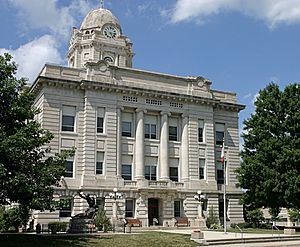
Newton was founded in 1846 and was first called Newton City. Its name was shortened to Newton in 1847. It officially became a city in 1857.
The city was named after Revolutionary War soldiers John Newton and William Jasper. This was a common way to name places back then. In the late 1800s, Newton grew because of coal mines nearby.
The Maytag Era
In the 1900s, Newton became a big manufacturing town. Much of its growth came from making washing machines. The beautiful Jasper County Courthouse, a famous building, was built in 1911.
Newton became well-known in 1938 during a workers' strike at the Maytag Washing Machine Company. The governor of Iowa, Nelson Kraschel, sent the Iowa National Guard to protect the company. The soldiers had tanks and machine guns ready. With this support, Maytag ended the strike, and workers had to return to work with less pay.
After World War II, the Maytag company grew even more. It became the Maytag Corporation. Maytag was famous for its reliable washing machines and dryers. The company even convinced Newton to change the address of its main office to "One Dependability Square."
In 2001, Maytag started to cut costs by moving some jobs to Mexico. More layoffs happened until 2005. Then, in 2006, another company called Whirlpool bought Maytag. This made people wonder what would happen to the Maytag plant in Newton.
On May 10, 2006, Whirlpool announced they would close the Newton plant and offices in 2007. About 1,800 people worked there at the time. In 2007, Whirlpool sold most of the Maytag headquarters to Iowa Telecommunications Services Inc. The Maytag plant officially stopped making products on October 25, 2007.
Newton's Comeback
After Maytag left, many people in Newton lost their jobs. The unemployment rate went up to almost 10%. But community leaders and the city government worked hard to create a plan for Newton's future. They wanted to bring new businesses to the city.
This plan worked! By 2013, the unemployment rate had dropped a lot. Even though Maytag left, Newton's population stayed steady, around 15,000 people.
Between 2007 and 2017, many new companies came to Newton. These included companies like Underwriter's Laboratory, Trinity Structural Towers, and TPI Composites. The Iowa Speedway also opened during this time.
The old Maytag corporate campus is now called Legacy Plaza. It has eight buildings from the early 1900s. This area was given to Des Moines Area Community College (DMACC) in 2016. Now, many different businesses and organizations rent space there.
Green Manufacturing in Newton
Newton has also attracted companies that make environmentally friendly products. In 2007, TPI Composites opened a factory to make huge wind turbine blades. Today, TPI Composites employs over 1,100 people. They even expanded to make parts for electric buses.
Another company, Trinity Structural Towers, opened in 2008. They make towers for wind turbines. President Barack Obama visited this factory on Earth Day in 2009. He said he came to Newton to start "a new era of energy exploration in America."
Because of its successful efforts to recover and grow in a sustainable way, Newton won the National Sustainable Community of the Year Award in 2010.
Newton's Future Plan
In 2012, the Newton City Council approved a plan called "Newton's Future: A Comprehensive Plan." This plan was created with ideas from the people of Newton. The main goals were to help Newton's population grow, especially with young families. They also wanted to create more jobs, make the city look nicer, and fill empty buildings.
Arts and Culture in Newton
Newton really supports the arts and culture.
Visual Arts and Sculpture
Newton has a lively arts community. Many artists live in the city, and there are several non-profit groups that support the arts.
From 2002 to 2017, Newton hosted the Iowa Sculpture Festival every year. This event celebrated sculpture as an art form and showed off works by local and international artists.
Newton has more than 100 public art displays, including sculptures and painted murals. You can take a self-guided tour to see them all year long.
The Centre for Arts and Artists opened in Newton in 2005. It has studios for 10 artists, a clay room, a special art room for children, and a classroom. It also has a large art collection and a gift shop. Classes for all ages are offered throughout the year.
Performing Arts
Newton also has a busy music and theater scene. Every summer, the city hosts the Bowlful of Blues. This festival at the Maytag Bowl features famous blues artists from all over the country.
The City of Newton also holds free weekly concerts at the Maytag Bowl during the summer. These "Concerts at the Bowl" feature local bands playing all kinds of music. The Newton City Band, made up of Newton citizens, also performs here.
The Newton Community Theater puts on several shows each year. These include big musicals like Les Misérables and smaller plays.
Historic Preservation
In 2014, Newton joined the Main Street Iowa program. This program helps cities with economic development while also preserving historic buildings. In September 2014, Newton's downtown area was added to the National Register of Historic Places. This means it's a special historic area.
The Fred Maytag Park Historic District, which includes Maytag Bowl, Maytag Park, and Maytag Pool, was also listed on the National Register in 2010.
Newton has several other places listed on the National Register of Historic Places. These include the Thomas Arthur House, the Jasper County Courthouse, and St. Stephen's Episcopal Church.
The Jasper County Historical Museum is in Newton. It has many old items from Newton's past, including early Maytag washing machines.
Other Fun and Culture
Newton Fest started in 2015. This annual celebration brings together art, food, music, and history.
Newton also hosts the Miss Iowa USA and Miss Teen Iowa USA Pageants every year. The winners go on to represent Iowa in the national Miss USA pageants.
Newton was home to one of America's first business airplanes. It was a Travel Air 6000 called "Smiling Thru." It belonged to Harry Ogg, who owned the Automatic Washing Machine Company.
Entertainment, Recreation, and Sports
In 1919, E.H. Maytag, whose father founded the Maytag Appliance company, bought a cow to get fresh milk for his kids. After E.H. passed away in 1940, his sons Fred and Robert took over the farms. Fred had an idea to create a special American blue cheese from cow's milk.
Maytag Dairy Farms worked with Iowa State University to create the first great American blue cheese. It was made to be as good as famous European cheeses. The cheese plant was finished in 1941, and the first wheels of Maytag Blue Cheese were made that October. Today, Fred's grandchildren are taking over the company.
Newton has two old movie theaters that are still open. The Valle Drive-in is one of only four drive-in theaters left in Iowa. It's the oldest, opening in 1948. The Capitol II Theater is in downtown Newton and has been open since 1927. It used to be a vaudeville theater.
Newton is home to Iowa Speedway, a 7/8-mile racing track. NASCAR bought it in 2014. It's the only short track owned by NASCAR west of the Mississippi River. The track hosts many races in the summer, including IndyCar Series and ARCA Menards Series races.
Newton High School competes in Class 4A sports through the Iowa High School Athletic Association. Their mascot is a Cardinal. They have teams for baseball, basketball, football, golf, soccer, softball, swimming, tennis, track & field, volleyball, and wrestling.
Newton has many parks and recreation areas. The city has 13 parks, including Maytag Park, which is the main park. Maytag Park is on the National Register of Historic Places. It has the Maytag Bowl (a historic stage), a public swimming pool, and a disc golf course. There's also the Newton Arboretum and Botanical Gardens, which has over 150 types of trees, a rose garden, a butterfly garden, and a native prairie.
Death of Rocky Marciano
On August 31, 1969, famous boxing champion Rocky Marciano and two other people died when their airplane crashed in Newton.
Education
The Newton Community School District provides public schools for students from kindergarten through 12th grade.
Newton Christian School is a private school for Preschool to 8th grade.
DMACC Newton Campus is a community college.
Geography
Newton covers about 11.19 square miles (29.37 square kilometers) of land.
Streets and Addresses
Newton's streets are set up in a special way. The city is divided into four sections by 1st Avenue (which runs east and west) and 1st Street (which runs north and south).
Roads called "avenues" run east and west. Roads called "streets" run north and south.
- A street name like "E 5th St S" means it's in the southeast part of Newton. The east or west part comes first, then the street name, then the north or south part.
- An avenue name like "N 5th Ave W" means it's in the northwest part of Newton. For avenues, the north or south part comes first, then the avenue name, then the east or west part.
All addresses in Newton use the 50208 ZIP Code.
Climate
Newton has a climate with hot summers and cold winters. It's known as a "hot-summer humid continental climate."
| Climate data for Newton, Iowa, 1991–2020 normals, extremes 1893–present | |||||||||||||
|---|---|---|---|---|---|---|---|---|---|---|---|---|---|
| Month | Jan | Feb | Mar | Apr | May | Jun | Jul | Aug | Sep | Oct | Nov | Dec | Year |
| Record high °F (°C) | 68 (20) |
72 (22) |
90 (32) |
96 (36) |
99 (37) |
102 (39) |
107 (42) |
105 (41) |
100 (38) |
95 (35) |
80 (27) |
74 (23) |
107 (42) |
| Mean maximum °F (°C) | 50.9 (10.5) |
56.8 (13.8) |
72.4 (22.4) |
82.4 (28.0) |
89.0 (31.7) |
93.3 (34.1) |
96.0 (35.6) |
93.8 (34.3) |
91.0 (32.8) |
83.4 (28.6) |
68.8 (20.4) |
55.8 (13.2) |
97.0 (36.1) |
| Mean daily maximum °F (°C) | 28.0 (−2.2) |
33.0 (0.6) |
46.4 (8.0) |
60.4 (15.8) |
71.4 (21.9) |
81.2 (27.3) |
84.6 (29.2) |
82.5 (28.1) |
76.2 (24.6) |
62.5 (16.9) |
46.7 (8.2) |
33.6 (0.9) |
58.9 (14.9) |
| Daily mean °F (°C) | 19.2 (−7.1) |
23.7 (−4.6) |
36.1 (2.3) |
48.8 (9.3) |
60.6 (15.9) |
70.6 (21.4) |
74.2 (23.4) |
72.0 (22.2) |
64.3 (17.9) |
51.5 (10.8) |
37.0 (2.8) |
25.2 (−3.8) |
48.6 (9.2) |
| Mean daily minimum °F (°C) | 10.7 (−11.8) |
14.4 (−9.8) |
25.8 (−3.4) |
37.1 (2.8) |
49.8 (9.9) |
60.0 (15.6) |
63.8 (17.7) |
61.4 (16.3) |
52.4 (11.3) |
40.4 (4.7) |
27.3 (−2.6) |
16.9 (−8.4) |
38.3 (3.5) |
| Mean minimum °F (°C) | −9.9 (−23.3) |
−4.8 (−20.4) |
6.0 (−14.4) |
23.7 (−4.6) |
37.1 (2.8) |
49.6 (9.8) |
55.2 (12.9) |
52.9 (11.6) |
39.3 (4.1) |
25.9 (−3.4) |
11.4 (−11.4) |
−3.1 (−19.5) |
−13.3 (−25.2) |
| Record low °F (°C) | −31 (−35) |
−34 (−37) |
−18 (−28) |
9 (−13) |
23 (−5) |
38 (3) |
44 (7) |
37 (3) |
23 (−5) |
13 (−11) |
−8 (−22) |
−22 (−30) |
−34 (−37) |
| Average precipitation inches (mm) | 0.93 (24) |
1.10 (28) |
2.06 (52) |
3.44 (87) |
4.84 (123) |
5.01 (127) |
3.93 (100) |
4.30 (109) |
3.59 (91) |
2.66 (68) |
2.01 (51) |
1.27 (32) |
35.14 (892) |
| Average snowfall inches (cm) | 9.2 (23) |
6.0 (15) |
4.5 (11) |
0.8 (2.0) |
0.0 (0.0) |
0.0 (0.0) |
0.0 (0.0) |
0.0 (0.0) |
0.0 (0.0) |
0.3 (0.76) |
1.6 (4.1) |
6.3 (16) |
28.7 (71.86) |
| Average precipitation days (≥ 0.01 in) | 6.4 | 6.3 | 8.0 | 10.1 | 11.8 | 10.5 | 8.3 | 8.8 | 7.4 | 7.6 | 6.2 | 6.9 | 98.3 |
| Average snowy days (≥ 0.1 in) | 4.1 | 3.7 | 1.7 | 0.4 | 0.0 | 0.0 | 0.0 | 0.0 | 0.0 | 0.2 | 0.8 | 4.0 | 14.9 |
| Source 1: NOAA | |||||||||||||
| Source 2: National Weather Service | |||||||||||||
Population of Newton
| Historical population | |||
|---|---|---|---|
| Census | Pop. | %± | |
| 1860 | 1,617 | — | |
| 1870 | 1,983 | 22.6% | |
| 1880 | 2,607 | 31.5% | |
| 1890 | 2,564 | −1.6% | |
| 1900 | 3,682 | 43.6% | |
| 1910 | 4,616 | 25.4% | |
| 1920 | 6,627 | 43.6% | |
| 1930 | 11,560 | 74.4% | |
| 1940 | 10,462 | −9.5% | |
| 1950 | 11,723 | 12.1% | |
| 1960 | 15,381 | 31.2% | |
| 1970 | 15,619 | 1.5% | |
| 1980 | 15,292 | −2.1% | |
| 1990 | 14,789 | −3.3% | |
| 2000 | 15,579 | 5.3% | |
| 2010 | 15,254 | −2.1% | |
| 2020 | 15,760 | 3.3% | |
| U.S. Decennial Census | |||
Newton's Population in 2020
In 2020, there were 15,760 people living in Newton. There were 6,750 households (groups of people living together) and 3,991 families. About 26% of households had children under 18.
Most people in Newton were White (89.6%). Other groups included Black or African American (2.8%), Native American (0.5%), and Asian (0.8%). About 3.8% of the population was Hispanic or Latino.
The average age in Newton was 41.6 years old. About 24.4% of residents were under 20, and 21.9% were 65 or older. There were slightly more females (51.8%) than males (48.2%).
Notable People from Newton
Many interesting people have connections to Newton:
- Matt Chatham – A football player who won three Super Bowls with the New England Patriots.
- Jay Clark – An Olympic sport shooter.
- Nick Easley – A football player who won the 2019 Outback Bowl MVP award while playing for the University of Iowa.
- Lyle Goodhue – A scientist and inventor who graduated from Newton High School.
- Sara Haines – A TV correspondent for ABC News and a co-host on The View.
- Emerson Hough – A well-known author.
- Sharon Needles – A famous drag queen who won RuPaul's Drag Race.
- Bessie Anderson Stanley – A writer known for her verse "Success."
Places to Visit in Newton
- Iowa Speedway
- Jasper County Historical Museum
- Newton Arboretum and Botanical Gardens
- Maytag Dairy Farms
- Historic Maytag Park
- Valle Drive-In (movie theater)
- Westwood Golf Course
Sister Cities
Newton has a special friendship with one city in another country:
 Smila, Cherkasy Oblast, Ukraine
Smila, Cherkasy Oblast, Ukraine
See also
 In Spanish: Newton (Iowa) para niños
In Spanish: Newton (Iowa) para niños



